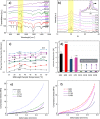3D Porous Graphene Based Aerogel for Electromagnetic Applications
- PMID: 31673020
- PMCID: PMC6823426
- DOI: 10.1038/s41598-019-52230-5
3D Porous Graphene Based Aerogel for Electromagnetic Applications
Abstract
Lightweight multifunctional electromagnetic (EM) absorbing materials with outstanding thermal properties, chemical resistance and mechanical stability are crucial for space, aerospace and electronic devices and packaging. Therefore, 3D porous graphene aerogels are attracting ever growing interest. In this paper we present a cost effective lightweight 3D porous graphene-based aerogel for EM wave absorption, constituted by a poly vinylidene fluoride (PVDF) polymer matrix filled with graphene nanoplatelets (GNPs) and we show that the thermal, electrical, mechanical properties of the aerogel can be tuned through the proper selection of the processing temperature, controlled either at 65 °C or 85 °C. The produced GNP-filled aerogels are characterized by exceptional EM properties, allowing the production of absorbers with 9.2 GHz and 6.4 GHz qualified bandwidths with reflection coefficients below -10 dB and -20 dB, respectively. Moreover, such aerogels show exceptional thermal conductivities without any appreciable volume change after temperature variations. Finally, depending on the process parameters, it is shown the possibility to obtain water repellent aerogel composites, thus preventing their EM and thermal properties from being affected by environmental humidity and allowing the realization of EM absorber with a stable response.
Conflict of interest statement
The authors declare no competing interests.
Figures




References
-
- Christopoulos, C. Electromagnetic Compatibility (EMC) in Challenging Environments. Operations Research, Engineering, and Cyber Security. Springer, Cham, 95–115 (2017).
-
- Yusoff AN, et al. Electromagnetic and absorption properties of some microwave absorbers. Journal of Applied Physics. 2002;92(2):876–882. doi: 10.1063/1.1489092. - DOI
-
- Ma J, et al. Systematic study of microwave absorption, heating, and microstructure evolution of porous copper powder metal compacts. Journal of Applied Physics. 2007;101(7):074906. doi: 10.1063/1.2713087. - DOI
LinkOut - more resources
Full Text Sources
Miscellaneous

